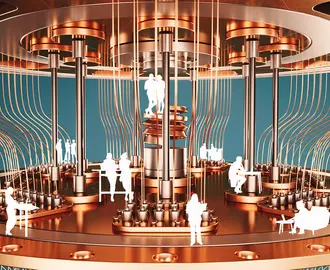Credit: Stephen Sauer
How can the U.S. economy generate more good jobs and greater economic opportunity throughout the country? MIT Sloan professor Simon Johnson and his colleague, MIT economics professor Jonathan Gruber, think they have an answer.
In their book “Jump-Starting America: How Breakthrough Science Can Revive Economic Growth and the American Dream,” Johnson and Gruber outline a bold plan to stimulate the creation of good jobs and increased economic prosperity across the U.S. In a recent conversation, Johnson discussed the proposal, the history of federal R&D, and why Rochester, N.Y. is the best place to start.
Your book highlights an interesting relationship between public policy and good jobs. Tell us a bit about that.
Well, Jonathan Gruber and I came to the view over a number of years that neither of the major political parties in the U.S. is sufficiently focused on what will create more good jobs. They mention good jobs, but it's not their top priority. So we investigated what could be a constructive path to get more good jobs — jobs that offer reasonably stable employment, a living wage, and decent benefits — into the mix in the U.S. We think that would include a federal government role as catalyst, but also a lot of local initiatives.
In the mid-20th century, the federal government in the U.S. provided a lot of support for the development and commercialization of innovative technology — and that contributed to economic prosperity. We propose to update that model and scale it up. We think some parts of the model still work very well — for example, the support that's provided through NIH (National Institutes of Health) to the development of new drugs, therapies, and medical devices. We could apply versions of that model to other dimensions of technology besides biomedical.
In particular, Jonathan and I argue that the U.S. should think about the geographic dimensions of where we develop technology. There are big economic spillover benefits to be had in innovation and in creating the foundation for the good jobs of the next decade. We should think about where we put that effort geographically, in order to pull more people into the modern technology-driven economy, which is something that is definitely needed right now.
In the book, you mention a number of historical examples of federal investments in research and development that led to the creation of new industries and jobs. Can you walk us through one of those examples — how the government invested and how that resulted in good jobs for Americans down the line?
Simon Johnson, Professor of Global Economics and Management, Co-Winner of the 2024 Nobel Prize in Economic Sciences
Radar is a good example. At the start of World War II, lots of countries were working on developing radar. The British had gotten a bit ahead with something called the cavity magnetron, but they couldn't develop it, because of the pressure of the war.
In 1940, the British shared their technology with their American allies, who were already interested in radar but had not made such big strides. The Americans scaled it up, and they developed a lot of the supporting technology that made it useful at MIT, in what was called the Radiation Lab, or Rad Lab.
Radar made a major contribution to winning World War II, particularly in defeating German U-boats. But commercializing radar also created the basis for modern civil aviation: Everything about how planes are flown and navigated and how we manage air traffic can be traced back to radar.
Aviation is not just a huge industry that provides thousands of good jobs in the U.S., but it's also a major defining characteristic of the modern economy. It all came out of that big push on radar and the way in which that technology was developed and subsequently deployed as a public-private partnership.
Is that a fairly typical way that these types of investments should play out, with the government investing in early R&D and then later on the private sector taking the technology in new directions?
Yes. The Human Genome Project is the best modern example of this kind of private-public partnership stimulating innovation. But there's a lot of evidence suggesting this is a more general phenomenon. It's in the public interest to have a lot of technological innovation, because the process of innovation creates good jobs. Also, businesses tend to develop close to where the innovation takes place.
And that closeness is not necessarily at the country level, it's even at the city level and within cities. You see it now in the neighborhoods around MIT and other technical universities. The U.S. R&D level has been fairly constant since the mid-1960s, but what's changed is the public component has declined and the private component increased. Private R&D works well for some fairly obvious applications with reasonably short time horizons. Companies, though, are not interested in fundamental breakthroughs and big new knowledge, because they can't generally figure out how to benefit from that directly themselves.
Suppose we make this kind of public investment in R&D again, the way you'd like to see it — with the investment spread out in different geographic regions. Obviously, that would generate good jobs for technical people. But are good jobs created for people who don't have PhDs or engineering degrees?
The evidence suggests that public investment in R&D creates a lot of jobs for people who don't have PhDs — in fact, for people who may not necessarily have finished college, as long as they get applicable vocational training, particularly in and around labs. Each PhD job comes with three to eight non-PhD jobs, and these are generally good, well-paying jobs, because you want people to be quite committed to them.
In addition, when a tech community develops, you get many ancillary jobs in the surrounding service sector. However, not all of those jobs are high-wage jobs, and making sure people are paid a living wage is something to be thought about in the local context.
In your book, you argue that a lot of U.S. cities have the potential to be tech centers but aren't, and that targeting public investment toward those cities could really make a difference. Tell us a little bit about some of those cities and the potential you see there.
Take Rochester, New York as an example. Rochester came out top in the index we included in our book of U.S. cities with potential to become tech hubs. Rochester is a place where there has been good technology in the past, if somewhat declined because of the problems of certain companies, including Kodak. Rochester's got a very high level of education and extremely strong universities. The cost of living there is low, and the infrastructure is very good.
As much as 90% of the U.S. population lives near a city or urban area with a population greater than 50,000.
And Rochester has already got a concentration of certain technologies such as photonics that seem important for the economy of the future. The U.S. Department of Defense agrees: It supports an advanced manufacturing institute based in Rochester around photonics.
It seems to us that a place like that has a lot of the ingredients necessary to be, not the next Silicon Valley, but a robust tech hub of some kind. And we see a lot of those places. We have 102 on the list in our book.
Can you explain how you think the selection and creation of these new technology hubs should work?
We think there should be some money that is the basis for a competition, where you ask places to put in bids to receive federal investment in a technology. It'd be very high-profile, like the bidding process for Amazon’s second headquarters a couple of years ago, except not trying to get communities to compete to give tax breaks to companies. Instead, we’re asking cities to say how they're going to invest in their local communities, as a way to match what the federal government is going to provide in investment.
That's the core of our idea. Some of this already exists in the advanced manufacturing institutes that were developed as part of the Revitalize American Manufacturing and Innovation Act of 2014. So we think there's a lot of potential bipartisan support for some version of this.
Your list includes both bigger cities like Atlanta and Houston and smaller ones like Rochester. What about really rural areas? Many of those struggle right now in the U.S. Is any of what you're talking about likely to spill over into those areas?
If we're talking about completely remote rural areas, our proposal is not particularly focused on that. But at least in our review of the data, there are relatively few Americans who live completely isolated from cities or urban areas of at least 50,000 population.
Any area that has that kind of concentration of population could become some sort of mini tech hub, in our view. And that could pull in or help connect people living in outlying areas. We think that 85-90% of Americans could quite readily fall within the catchment area of one of these potential hubs.
But that's not everyone. So we should also think about other policies that could be helpful to people who live in more remote communities.
Is that where your proposal for a national innovation dividend comes in? Can you explain that proposal?
An innovation dividend could arise in various ways. The one that we're proposing is that the federal government and the local government would both contribute land and develop land in and around these new hub areas where public investment is being made, and that you will over time see an appreciation in the value of that land — much the way land around MIT and in Silicon Valley has appreciated. Thinking about that land as an investment portfolio and the government as a type of real estate manager, there should be ways to either take some of the increase in rents and/or the capital appreciation of the real estate to create an endowment for a dividend fund to benefit all U.S. citizens.
Alaska does something similar with oil revenues. In Alaska, if the price of oil goes up or goes down, that is reflected, essentially, in the dividends state residents receive. So there's an incentive and a desire on the part of residents, presumably, for higher oil prices and more oil revenue. Our point is, at the national level, why not create an incentive for more support of tech development?
If your ideas were implemented, what do you think would be the effects, 20 years from now, on the U.S. economy and employment?
We think it would create a lot more good jobs — millions of good jobs, depending on the scale you pursued this at. That would be a pretty transformative change in the nature of economic opportunity in the U.S. — and in who gets to participate in the modern tech economy.
The fear is if we don't do something like this, technology will be developed around artificial intelligence, self-driving vehicles and what have you, and we may generate jobs to replace those lost to automation, but we won't generate good jobs. We'll be buying technology from other countries and they'll have the jobs in technology development, while we will have a lot of low-end service jobs that don't pay good wages.



